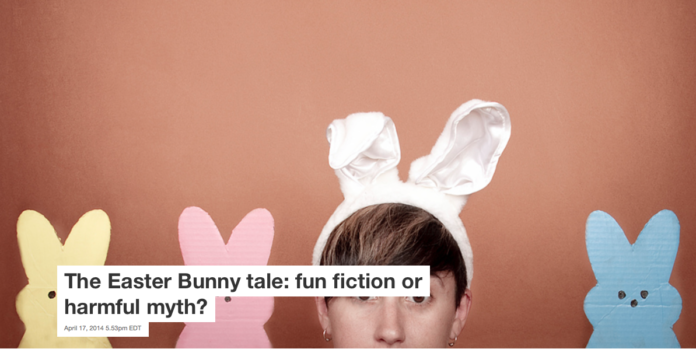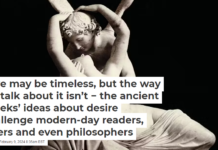

Victoria Metcalf, Lincoln University, New Zealand
All around the world many parents are preparing for Easter – possibly thinking of how Easter eggs will be hidden, how they will explain their delivery and perhaps bracing themselves for some challenging questions about the Easter Bunny.
But before parents figuratively dust off the Easter Bunny myth for its annual delivery of fiction presented as fact, is there time to pause, mid-bounce, to examine whether engaging in this deceit may be detrimental to our children?
Many are getting excited about the game they are going to play with their children, but this is a one-sided game where the children don’t know the rules; they’re participating in something that’s presented to them as a fun reality.
Final fantasy
Three major fantasy characters pervade Western culture: Santa Claus, the Tooth Fairy and the Easter Bunny.
Children tend to believe in these fantasy figures as a function of age and in relationship to their promotion by parents.
A 2011 study found an important transition occurs about six years of age where children begin to distinguish fantasy figures as capable of violating real world causal principles (they recognise make-believe figures can do things humans can’t). Even very young children (aged three to five years) can recognise fantasy figures as different.
Contrary to the thought that the shift to viewing fantasy figures as violating causal principles may be responsible for children’s ability to discern the fictional nature of such characters, this study did not find that relationship. In other words, there is no sudden insight that such figures cannot be real.

Nongbri Family Pix/Flickr, CC BY-ND
Many parents promote belief in these fantasy figures as harmless fun, part of upholding the innocence of childhood or even that they help fantasy play and critical thinking.
Others question whether promoting such deceits is in children’s best interests. There has been surprisingly little research conducted to look at impacts our societal investment in these figures has on children.
Emotional effects
In 1994, researchers examined children’s reactions to discovering the myth (in the case of Santa) and found that children exhibited many positive or negative reactions to the truth, but in general without significant distress.
How terms were defined, though, may be a key flaw in the study. Some 71% of children reported being “happy” about learning the truth, but that “happiness” could be associated with negative feelings – happy their instinct was right, that they now knew about their parent’s deceit.
Although the authors downplayed the intensity of the negative impacts on children, such impacts were not trivial:
- 50% of surveyed children felt bad
- 48% felt sad, disappointed or tricked
- 42% felt confused
- 35% felt angry
- 33% felt upset
- 29% felt sorry
- 13% felt hurt.
And while some – if not many – children may appear to suffer little ill effects when the deceit is unveiled, others potentially do.
An oft-quoted piece by science writer Melinda Wenner Moyer contains the idea fantasy figures (again focusing on Santa) are not only beneficial for children’s cognitive development, but perhaps even necessary.
Psychologist William Irwin and philosopher David Johnson counter that this kind of deceit “doesn’t actually promote imagination or imaginative play” because to imagine means that you pretend, and to pretend something exists you need to believe first that it doesn’t.

One lie leads to another
Studies show that lying as a parental tool is incredibly common. Research published last month on the effects of adult lies on children suggests that parents reconsider the use of these deceits as harmless fun.
Lying by an adult (in this case an adult unknown to the child) affects a child’s honesty (186 children were tested, aged three to seven – the very age group likely to believe in the Easter Bunny when parents promote the story).
Lied-to school-aged (but not preschool) children were more likely to cheat and then lie to cover up their cheating.
The authors caution further studies are needed using the parent as the experimenter to ascertain if trust violations lead to even more dishonest child behaviour or if the parent-child relationship (presumably depending on the degree of attachment) makes children immune to any parental lie-telling effects.
In the meantime though, it’s worth spending time peeling off societal and familial filters to uncover your own values about the big three – Easter Bunny, Santa and the Tooth Fairy – and ask whether the deceit really works for your family.
This Easter perhaps consider gently giving your children a basketful of honesty about who really supplies the Easter eggs.
![]()
This article was originally published on The Conversation.
Read the original article.



















